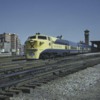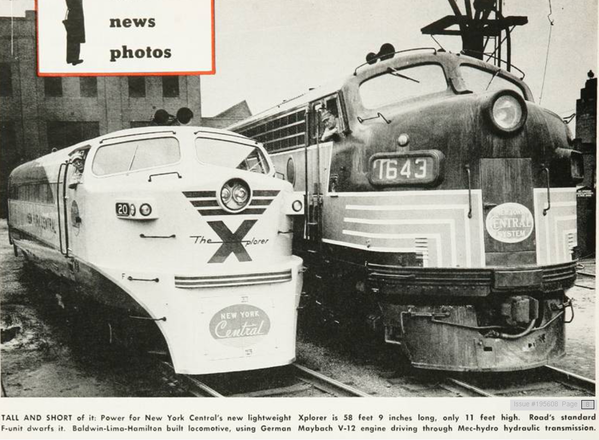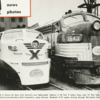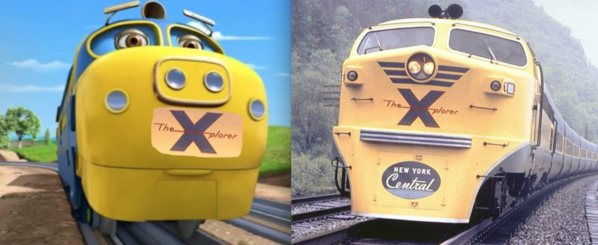 The images attached to Silver Lake's previous post in this thread reflect not one, but two lightweight designs. The Boston & Maine's "Speed Merchant" is actually a talgo train-set with a single FM diesel-electric on each end. It was basically the same as the New Haven's "John Quincy Adams" (not pictured). They were the only examples of this particular lightweight type. However, the Rock Island mated a set of the same fifteen ACF cars with GM's "Aerotrain" engine and called the result, "The Jet Rocket".
The images attached to Silver Lake's previous post in this thread reflect not one, but two lightweight designs. The Boston & Maine's "Speed Merchant" is actually a talgo train-set with a single FM diesel-electric on each end. It was basically the same as the New Haven's "John Quincy Adams" (not pictured). They were the only examples of this particular lightweight type. However, the Rock Island mated a set of the same fifteen ACF cars with GM's "Aerotrain" engine and called the result, "The Jet Rocket".
The New Haven's "Dan'l Webster" (shown above) was a "Train-X" design and a close sister to the New York Central's "Xplorer". Both featured nine-car-train-sets, but the "Xplorer" only utilized one engine. The "DW" had one on each end. The NYC train also featured a shark-nose on its Baldwin-Lima-Hamilton diesel-hydraulic loco. Combined with the "Xplorer" logo graphics, this gave the unit a Mighty Mouse appearance, and the train came to be referred to by that name.
Models of the "Aerotrain" (with GM bus-body coaches) are now available in O and HO scale. Certainly, this is because it was the most promoted of the 1950s lightweights. GM's two demonstrator-trains were eventually sold to the Rock Island (the "Jet Rocket" being the third lightweight they operated), but only after they had toured some 30 US railroads. Four roads eventually leased the trains for revenue and performance tests. Hence, the "Aerotrain" allows a model-manufacturer to offer it in 5 prototype railroad names, as well as the widely toured GM-demonstrator. The minor paint-and-decal differences on these 6 train-sets are also easy to accommodate. The model's tooling requires only an engine, a single bus-style coach, and the modification of this car for an auto-style rear observation window. Little wonder that the "Aerotrain" has been widely produced and the other 1950s lightweights have yet to appear.
If a model train manufacturer were to consider the BTO sales potential of another lightweight, " Train-X" would probably be the most likely choice. The New Haven and the New York Central were centered in densely populated areas of the US and have many modelers. Both the "Dan'l Webster" and "Xplorer" feature unique low-profile dimensions and colorful paint schemes.
In 1963, the New York Central sold its train (in storage, since 1960) to Jones Tours, a subsidiary of the Pickens RR, a class-3 short line in South Carolina. Late in 1964, it was joined there by the NH lightweight, which had been out of service since 1958. Both were operated under the "Xplorer" name from 1964-67, in passenger excursions over Seaboard, Atlantic Coast Lines, and Southern Railways. They were pulled by locomotives of their respective hosts (often a GP-9), with in-train electricity provided by the auxiliary diesel-powered generator onboard the Baldwin R-210 locomotives.
I've been told that these excursions were mostly between Charlotte, North Carolina, and Atlanta, Georgia, but ranged as far as Alabama and Florida, making overnight hotel-stops in key cities along the way . The trains also saw some shuttle service on Pickens' light-rail (100 lb.) trackbed, over their ten route miles between Pickens and Easley. They initially received a black-and-aluminum paint-scheme (later altered to dark blue-and-aluminum) and retained the "X-plorer" logo-graphics of the New York Central on the nose of the locomotives. When James F. Jones sold the Pickens RR in 1967, the train-sets went into storage on a siding at Traveler's Rest, SC. There they remained, until scrapped in 1970.
So the range of prototype RR operations (while not as comprehensive as the "Aerotrain") is possibly sufficient for marketing. However, the model's tooling would be more complicated than GM's train. First, there's the difference in the two Baldwin locomotive noses. Then the train-set requires a single-axle 5-window coach, a single-axle 6-window variant, and the re-tooling of the 5-window coach as a mid-train-car riding on two axles (to increase stability in the prototype). The New Haven's units also featured 3rd-rail pick-up shoes on their trucks, and a unique half-scale, roof-mounted scissor pantograph, for reaching the overhead 3rd-rail bar used to power trains through the maze of switches in New York City's Grand Central Terminal, where positioning a standard 660-volt 3rd-rail at trackside was not feasible.
Someday, perhaps we'll see "Train-X" arrive.






















